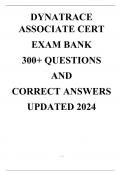Exam (elaborations)
DYNATRACE ASSOCIATE CERT EXAM BANK 300+ QUESTIONS AND CORRECT ANSWERS UPDATED 2024
- Course
- Institution
DYNATRACE ASSOCIATE CERT 1. Mission Control: Managed customers can use this to access their clusters, check for system updates 2. SaaS Updates: SaaS updates are done automatically 3. ActiveGate: Proxy between OneAgent and a database, cloud, etc. 4. ActiveGate use cases: Access seale...
[Show more]



